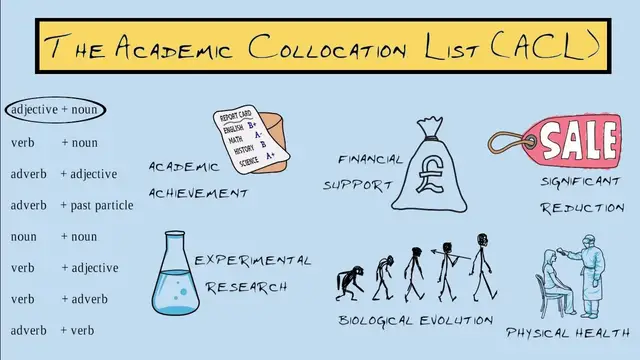The Academic Collocation List (ACL)* is a list containing 2,469 of the most frequent and useful collocations which occur in written academic English. This video gives an overview of the Academic Collocation List, with some examples, as well as some ways you can learn collocations in the ACL, namely:
1. Study words by type e.g. adj + n
2. Study collocation families e.g. academic circles, academic achievement, academic career
3. Use the ACL highlighter
4. Combine with study of the AWL
5. Learn common frames e.g. highly + charge/correlated (with)/developed/educated/structured/valued
6. Learn 10 collocations a day
* CORRECTION TO VIDEO: The list is the Academic Collocation List (singular), not Academic Collocations List (plural) as referred to in the video.
▬ Contents of this video ▬▬▬▬▬▬▬▬▬▬▬▬▬▬▬▬▬▬▬▬
00:00 Intro
00:28 What are collocations?
02:01 What is the Academic Collocation List?
05:27 Learning academic collocations
10:54 Summary
▬▬▬▬▬▬▬▬▬▬▬▬▬▬▬▬▬▬▬▬▬▬▬▬▬▬▬▬▬▬▬
Video created using VideoScribe software [affiliate link]:
https://tidd.ly/37VdIB7
Show More Show Less View Video Transcript
0:00
This video is brought to you by eapfoundation.com, the website for all your academic English needs
0:07
So this video will focus on the Academic Collocations List, or ACL
0:12
And I'll be looking at three things. First, we'll see what collocations are
0:17
Then we'll look in detail at the Academic Collocations List with some examples
0:22
And I'll finish up by giving some ideas about how you can learn academic collocations
0:28
So let's begin by considering what collocations are. So the word collocation can be broken down into the prefix co- and the root location
0:37
Co- means together, while location means place. And a collocation is two or more words that often occur, in other words are placed, together
0:49
A simple example of a collocation is heavy rain. This is an adjective and noun collocation
0:56
And this is an everyday, not an academic collocation. And I'm going to look at the same collocation in different languages
1:04
because collocations are not just something that exist in English. In fact, about half of collocation errors are because of mother tongue interference
1:12
So in Chinese, this is 大雨 dà yǔ, which means big rain
1:17
French and German are actually similar. In French, it's fort prix. And in German, stark regen, which means strong rain
1:27
In Spanish, it's lluvia pesada, which, like English, means heavy rain. In Persian, it is baran shadid, which means intense rain
1:38
While in Arabic, it is matakhazir, which means copious rain. And if you use one of these other collocations, strong rain, big rain, intense rain
1:50
people might understand you, or they might not. But anyway, it would not sound natural
1:55
So using the right collocations in writing or speaking will help you to communicate the message and to sound more natural
2:02
So let's move on to look at the academic collocations list. So this is a list that was developed by two researchers, Kirsten Ackerman and Yuhua Chen
2:11
using the Pearson International Corpus of Academic English, PICAE. And the academic collocations list contains 2,469 of the most frequent collocations
2:22
in written academic English. And in the corpus under study, it covers 1.4% of texts
2:29
which compares to 0.1% of general English texts. And the collocations contained in the list are only lexical collocations
2:37
not grammatical collocations. In other words, the list contains adjective and noun collocations
2:44
verb and noun, adverb and adjective, adverb and past participle, noun and noun, verb and adjective, verb and adverb, and adverb and verb collocations
2:54
These are lexical collocations. And what it doesn't contain is grammatical collocations
2:59
verb and preposition, such as look at, look into, or adjective and preposition, such as good at, interested in, beneficial for, and so on
3:10
So let's look in more detail at the different types. So here they're listed in order of frequency
3:16
So the most common type of academic collocation are adjective and noun collocations
3:21
And there are 1,773 of these, which means adjective and noun collocations comprise 72% of all the collocations in the ACL
3:31
Why are there so many of this type? Well, it might be because of the high use of nouns in academic writing
3:37
Academic writing tends to use lots of nouns or noun phrases, nominalisation
3:42
So let's have some examples. I'll just give six examples of adjective and noun collocations
3:47
So academic achievement, experimental research, financial support, significant reduction, biological evolution, and physical health
4:00
Now those are just some examples. The second most common type are verb and noun collocations
4:06
And there are 310 of these, or 13% of collocations in the ACL
4:12
So together, the first two types, adjective and noun, verb and noun, comprise 85% of collocations in the ACL
4:20
So examples of these, achieve a goal, reduce emissions, resolve a conflict, accept responsibility
4:30
The next most common type, adverb and adjective. There are 124 adverb and adjective collocations in the ACL, which makes up 5%
4:38
For example, clearly visible, freely available. Adverb and past participle also have 124 collocations in the list, also 5%
4:49
For example, carefully controlled, easily understood. There are 62 noun and noun collocations, which is 3%
4:56
For example, background knowledge, survey data. 30 verb and adjective collocations, 1% of the total
5:05
For example, prove useful, seem unlikely. 29 verb and adverb collocations, again 1%, such as behave differently, vary widely
5:16
And 17 adverb and verb collocations, also 1%, actually less than 1%
5:22
For example, directly affect, and strongly suggest. So let's look now at some ideas about how to learn academic collocations
5:32
So one way you can learn collocations is to study them by type
5:36
For example, adjective and noun collocations. Another idea is to study collocation families
5:43
A third idea is to use the ACL highlighter. Another idea is to combine study of the academic collocations list with the academic word list
5:51
Those four ideas can all be done using the EAP Foundation website
5:56
So here's the page on academic collocations list. This gives all of the words in the ACL sorted by type
6:03
So you can see here the adjective and noun collocations at the top
6:07
And as I said, this is 72% of the total, so there are a lot of collocations here
6:18
Then adverb and adjective collocations. Adverb and verb collocations, not so many of those
6:23
Adverb and past participle. Noun and noun collocations. Verb and adjective, again, not many
6:29
Verb and adverb. And verb and noun, which, remember, are the second most common type, so quite a few of those
6:36
So studying collocations by different type is one way that you can learn collocations
6:43
Perhaps a more useful way is the second idea, to study collocation families
6:48
So this page gives, again, the academic collocation list collocations, but sorted into families, grouped under headwords
6:57
So the first three entries only have a single collocation, but then if we go down to the fourth one, which has the headword Academy
7:03
you can see many different collocations in this list. Academic circles, academic achievement, which we just saw
7:09
academic career, academic community, academic debate, and so on. So learning words by studying the collocation families
7:16
is another way to learn words in the academic collocations list. So the third idea I just gave was using the ACL highlighter
7:24
Again, this is on the EAP Foundation website. So to demonstrate this, I'm going to take the text from the British Medical Journal
7:31
So I'm just going to highlight the beginning part of this article. This is just an example of an academic text
7:36
Paste it into the highlighter. And then you can see here the academic collocations in the text
7:42
So here we have media coverage, domestic violence, sexual violence, natural disasters
7:48
increase the likelihood, close contact, and provide support. And the ACL highlighter is useful because it also sorts them by type
7:56
Remember, the ACL covers 1.4% of text, so we're not expecting very many collocations to appear in the total text
8:04
And so the fourth way I just gave of studying academic collocations
8:08
is to combine study with the academic word list, which you might be studying already
8:13
So one tool that could be used to do this, again on the EAP Foundation website
8:17
is what's called the AWL Word Finder. So let's choose a word here
8:22
Let's just choose assess, a random word. So you can see here, so this gives information about the word
8:28
related word form, meaning, pronunciation. But it also lists words in the academic collocations list
8:34
A different example, benefit. Again, listing words in the academic collocations list
8:40
Beneficial effects provide a benefit. Economic benefits, potential benefits. Actually, another way that you can combine study of the AWL and the ACL
8:49
is on the page which listed words by head word. You can use the All widget for this
8:54
and then this will highlight words which are contained in the AWL
8:58
So you can see the first example, cognitive ability. Neither of those words are in the AWL
9:03
The second example, abstract concept. Both of those words are in the AWL
9:08
The third example, sexual abuse. Sexual is in the AWL. Abuse is not
9:13
So another way that you can learn academic collocations is to learn common frames
9:18
And this idea was actually given by Ackerman and Chen in their original article. Some of the other ideas here were as well
9:23
So for example, the word highly has several collocations in the list
9:27
But six of them are with the past participle. So we have highly charged, highly correlated with
9:33
highly developed, highly educated, highly structured, and highly valued. So studying some frames like adjective and past participle
9:42
might be another way to learn words in the academic collocations list. And the last idea I'd like to give you is to learn a few every day
9:48
maybe just ten every day. And let's try that because we had ten collocations in this video
9:53
How many of them do you remember? So these are the images that went with the collocations
9:59
So the first one is academic achievement, financial support, reduce emissions
10:11
experimental research, significant reduction, physical health
10:24
biological evolution, resolve a conflict, accept responsibility
10:38
and achieve a goal. So that's the end of the video. So we looked at three things
10:47
We've seen what collocations are. We've seen what the academic collocation list is, the ACL
10:55
And we've seen six ways to learn academic collocations. So that's the end of the video
11:09
I hope you found it helpful. And I hope you've learned something. And I hope you've learned something. And I hope you've learned something
11:13
And I hope you've learned something. And I hope you've learned something. And I hope you've learned something. And I hope you've learned something
11:17
And I hope you've learned something. And I hope you've learned something. And I hope you've learned something. And I hope you've learned something
11:21
And I hope you've learned something. And I hope you've learned something. And I hope you've learned something. And I hope you've learned something
11:25
And I hope you've learned something. And I hope you've learned something. And I hope you've learned something. And I hope you've learned something
11:29
And I hope you've learned something
#Academic Conferences & Publications



